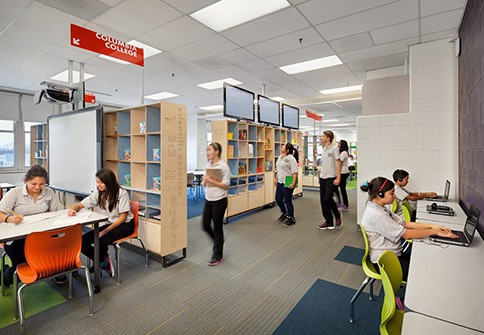New Classrooms’ Blended Math Program Yields Big Gains for Struggling Students

Nonprofit R&D shop New Classrooms powers middle school math programs in 15 high poverty schools. A report out today shows promising results from their blended learning Teach to One program.
About 6000 middle grade students, most of whom had initial mathematics skills that were well below national averages, made 1.5 years of progress during the second year of Teach to One implementation according to Dr. Douglas Ready of Columbia University’s Teachers College.
Measures of Academic Progress (MAP) from NWEA was used to calculate growth (an approach we support for developing comparable growth measures).
The report showed that students who started with the weakest mathematics skills made the largest gains. Students who began the year below grade level made 1.8 years of progress. Last year, gains in 11 of 15 schools were significantly above average.
Two weeks ago, lawmakers attending the National Summit on Education Reform (#EIE14) were able to visit a Teach to One deployment at Hart Middle School, in the Ballou High School feeder pattern–one of two blended feeder patterns in development in Washington DC. The policy makers witnessed the individual rotation model in action. A short quiz at the end of every session drives a recommendation engine which develops a suggested schedule for every student every day that is customized to individual academic goals. Students rotate through eight different instructional stations.
In the 2013-14 school year Teach to One was in 15 public schools—six in New York City, three in Chicago, one in North Carolina, one in Washington, DC and four in Northern New Jersey.
Backstory. While serving as the Chief Talent Officer of the NYC DOE, Joel Rose, developed School of One as a summer school program. With Christopher Rush, Rose build a small team and piloted the program in three NYC schools. School of One was named one of TIME magazine’s top 50 inventions of 2009. Rose and Rush set up an independent nonprofit to develop and scale the invention.
The New Classrooms team has reviewed 80,000 math learning experiences and placed 10,000 of them in the Teach to One library. The team is continuing to improve the recommendation engine and scheduling system.
The models produce remarkable benefits for teachers. Imagine teaching a small group lesson to students that have demonstrated readiness for that lesson, in that modality, on that day–benefits of a predictive algorithm and dynamic scheduling. However, some implementations have resulted in staff turnover because the teaching role is much different than in a teacher-centered classroom.
While future versions will likely become more affordable, the innovative program is relatively expensive and initial deployments requires substantial technical assistance. It is, however, the best picture of personalized learning out there.
For more on personalized learning, check out:
- Fueling A Personalized Learning Revolution in Secondary Education
- Rand Student Says Personalized Learning Boosts Academic Gains
- Lighting the Path to Personalized Learning
Feature photo via Facebook.com/NewClassrooms.




0 Comments
Leave a Comment
Your email address will not be published. All fields are required.